Click below to jump to an article of interest.
Studying Endangered Spring System
SwRI hydrologists are conducting a targeted water-sampling campaign of the Las Moras Springs system near Brackettville, Texas. The project will analyze and characterize the system of springs and its relationship to the Pinto Creek watershed to improve water management and conservation efforts.
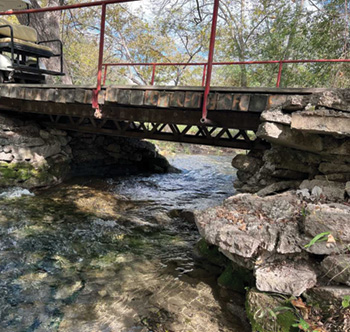
“Las Moras, like many other Texas spring systems, is at risk and prone to going dry. It is important to clear up uncertainties about their source and relationship with the neighboring Pinto Creek watershed,” said SwRI Research Scientist Mauricio Flores, who is leading the project.
Using advanced chemical testing, Flores hopes substances found in the samples will shed light on exactly where the spring water originates and how it arrives at Las Moras Springs. The team will also compare current and historical data to estimate the amount of groundwater that’s regularly pumped from the regional water system. Excessive groundwater pumping and recurrent drought, which can reduce water flow and cause subsequent water quality issues, threaten Las Moras Springs and water security in Kinney County.
“Without better understanding of the source area and relationship with neighboring watersheds, it will continue to be difficult to effectively manage those water resources,” said Flores.
The Las Moras Springs system flows from the Edwards Aquifer, discharging 12–14 million gallons of water a day, providing water for people living in Kinney County. The surrounding area also provides habitat for an array of plants and wildlife, including the threatened Devils River minnow and endangered golden-cheeked warbler. Las Moras adds to the cultural landscape in Brackettville and surrounding communities, dating back thousands of years.
The project is funded by a $50,000 grant from the Coypu Foundation, which supports environmental research.
New Chamber Tests Spacecraft
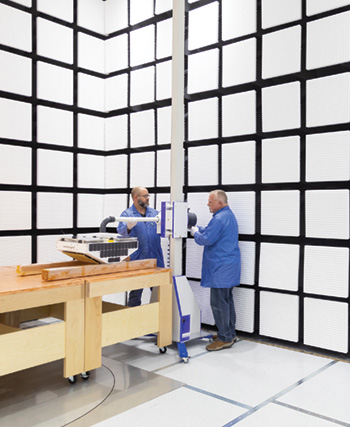
SwRI’s new semi-anechoic shield enclosure is designed to perform EMC/EMI and radio frequency testing for spacecraft.
SwRI has added a semi-anechoic shielded enclosure for electromagnetic compatibility and interference (EMC/EMI) testing for spacecraft. The test chamber is part of the turnkey Spacecraft Integration and Test Center within its 74,000-square-foot Space System Spacecraft and Payload Processing Facility.
The 400-square-foot EMC/EMI chamber is semi-anechoic, or free of echo, and shielded from electromagnetic interference. It performs standard emissions and susceptibility testing with an upper frequency limit of 40 gigahertz (Ka-band). It also supports spacecraft self-compatibility testing, which ensures that spacecraft subsystems and components work correctly and do not interfere with each other. The chamber will also evaluate radio frequency performance and compliance, important capabilities for wireless and telecommunications operations.
“This new chamber performs tests that indicate how a spacecraft will respond to a space environment. It incorporates significant automation, allowing us to test satellites and instruments quickly and efficiently while maintaining appropriate cleanliness levels,” said Institute Engineer John Stone. “Locating the EMC/EMI chamber adjacent to other test facilities will also reduce the time lost and risk associated with moving between facilities.”
The chamber is part of an 11,000-square-foot environmental testing facility, which includes a high-decibel acoustic test chamber.
Developing Tomorrow's Antibiotics
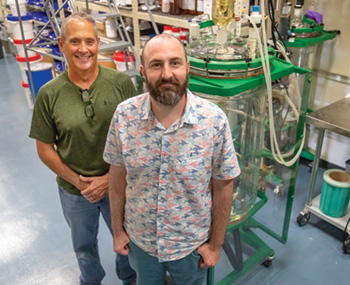
SwRI’s Dr. Shawn Blumberg (right) and his co-principal investigator, Dr. Stanton F. McHardy of UTSA’s College of Sciences, will use funding from the SwRI/UTSA Connect program to develop a synthesis process to create a pipeline of new polycyclic antibiotics.
SwRI is collaborating with The University of Texas at San Antonio (UTSA) to explore and develop a novel platform or chemical process for synthesizing antibiotic compounds. The project is supported by the Connecting through Research Partnerships (Connect) program designed to foster collaboration between SwRI and UTSA.
“SwRI and UTSA will work together to combat the growing threat antimicrobial resistance poses to global health by developing a proof-of-concept platform to potentially create a whole library of new antibiotics,” said Dr. Shawn Blumberg, a lead scientist in SwRI’s Chemistry and Chemical Engineering Division and co-principal investigator (PI) of the project.
The World Health Organization (WHO) estimates antimicrobial resistance is either a direct cause or a contributing factor in millions of deaths worldwide each year. The crisis is exacerbated by what WHO calls “an antibiotics pipeline and access crisis.”
Blumberg and his co-PI, Dr. Stanton F. McHardy of UTSA’s College of Sciences, will focus on creating a pipeline of new polycyclic antibiotics. This class of antibiotics includes tetracyclines, commonly used to treat pneumonia; anthracyclines, used to fight cancer; and polycyclic xanthones, natural compounds with known health benefits.
“Polycyclic xanthones offer a variety of potential therapeutic applications, but they haven’t been assessed yet,” said McHardy. “With the new synthesis process, we’re hoping to rapidly access a unique class of chemical building blocks, structural analogs and new compounds.”
The team plans to use the process to discover more effective tetracycline antibiotics and safer anthracycline treatments with fewer side effects. Blumberg and McHardy also hope to create synthetic polycyclic xanthones that can mimic natural analogues while delivering new mechanisms of action or new ways of fighting infections.
Pluto-Charon Formed By 'Kiss and Capture'

IMAGE COURTESY SwRI/ADEENE DENTON/ROBERT MELIKYAN
A NASA postdoctoral researcher at SwRI has used advanced models that indicate that the formation of Pluto and Charon may parallel that of the Earth-Moon system. Both systems include a moon that is a large fraction of the size of the main body, unlike other moons in the solar system. The scenario also could support Pluto’s active geology and possible subsurface ocean, despite its location at the frozen edge of the solar system.
“We think the Earth-Moon system initiated when a Mars-sized object hit the Earth and led to the formation of our large Moon sometime later,” said Dr. Adeene Denton, who led the research published in Nature Geoscience. “In previous models, when proto-Charon hit proto-Pluto, you have a massive shearing effect of fluids that looks like two blobs in a lava lamp that bend and swirl around each other. Adding in structural properties allows friction to distribute the impact momentum, leading to a ‘kiss-and-capture’ regime.”
When Pluto and Charon collide, they stick together in the shape of a snowman. They rotate as one body until Pluto pushes Charon out into a stable orbit. And this collision scenario supports the formation of other moons, such as Pluto’s four other tiny, lumpy satellites.
This new model tells us how the impact may have happened but not when, which is significant, particularly because Pluto is thought to be geologically active and may have a liquid ocean beneath its icy surface.
Sustaining Aging Aircraft
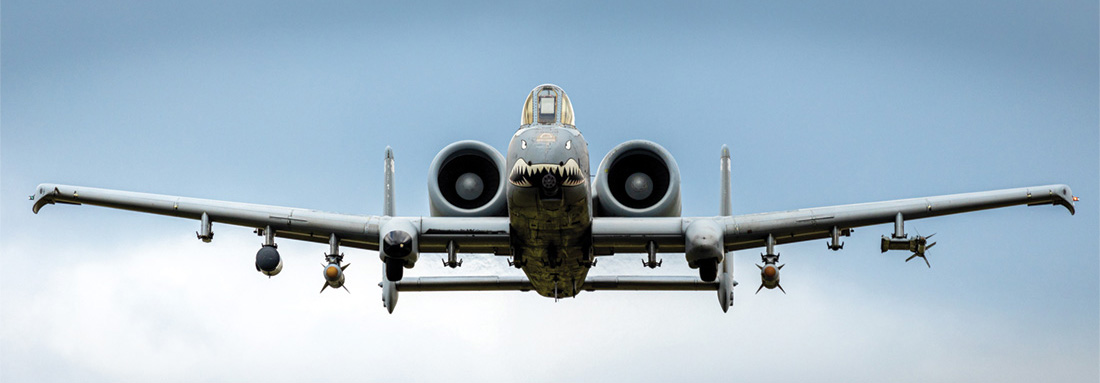
The A-10 Thunderbolt, a close air support attack aircraft first introduced in the 1970s, is one of three aging military fleets that SwRI is helping the U.S. Air Force maintain under a pair of new contracts.
Under two U.S. Air Force contracts totaling $23 million, SwRI engineers will address aging aircraft structures and material degradation. The Institute will help the Air Force modernize methods to sustain the T-38 Talon, the A-10 Thunderbolt and the B-52 Stratofortress, three military platforms nearly 50 years old.
“SwRI will assist with the full spectrum of structural sustainment for these aircraft,” said Luciano Smith, manager of SwRI’s Structural Integrity Section. “Our analyses will help the Air Force know when, where and how often to inspect the aircraft to determine when structural repairs are necessary.”
For several decades, SwRI has provided technical engineering support to the Air Force to extend the life of aircraft that came into service in the ‘60s and ‘70s and have exceeded their design life.
“SwRI has worked with the Air Force to maintain the structural integrity of the A-10 for more than 20 years and the T-38 for more than 40,” said David Wieland, who oversees the Institute’s Aerospace Structures Section. “Under these new contracts, we will perform design, analyses, testing and nondestructive inspections. We will also evaluate flight data recording, usage monitoring and individual aircraft tracking systems.”
The structural integrity and performance of all three fleets of aircraft are evaluated under simulated real-world conditions.
Flow Features on Airless Worlds
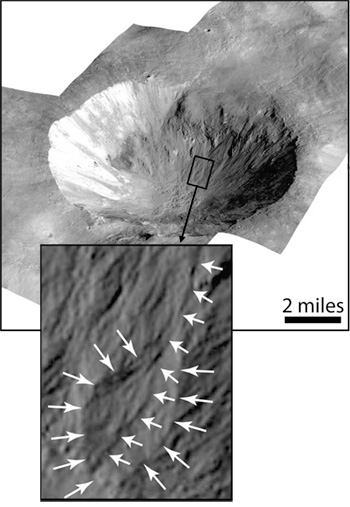
IMAGE COURTESY JET PROPULSION LABORATORY
The Cornelia Crater on Vesta (top) features lobate deposits and curvilinear gullies (highlighted by white arrows, bottom) that may have formed from melted ice following a meteoroid impact.
In collaboration with NASA’s Jet Propulsion Laboratory, SwRI scientists found evidence to explain the presence of mysterious flow features on the surfaces of airless celestial bodies, such as the asteroids Vesta and Ceres.
The SwRI-JPL team studied how post-impact conditions, such as from a meteoroid strike, could produce liquid brines that temporarily flow on the surface long enough to etch curved gullies and deposit fans of debris in the walls of newly formed craters.
The project investigates a previously proposed idea that an impact could excavate and melt subsurface ice, which then flows along the walls of the impact crater to form distinct surface features. The team wanted to understand how long the liquid could potentially flow before refreezing. The team modified a JPL test chamber to simulate dramatic pressure drops on an airless body like Vesta. Dissipation of this temporary postimpact atmosphere could help determine how it affects liquids.
“Through our simulated impacts, we found that the pure water froze too quickly in a vacuum to effect meaningful change, but saltwater mixtures, or brines, stayed liquid and flowing for a minimum of one hour,” said SwRI’s Dr. Michael J. Poston, lead author of a new paper published in The Planetary Science Journal about this work. “This is sufficient for the brine to destabilize slopes on crater walls on rocky bodies, cause erosion and landslides, and potentially form other unique geological features found on icy moons.”
New Solar Composition Ratios
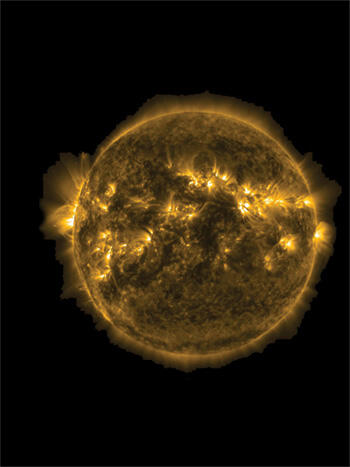
IMAGE COURTESY NASA/SDO/AIA
An SwRI-led team combined compositional data of primitive bodies like Kuiper Belt objects, asteroids and comets with new solar data sets to develop a revised solar composition that potentially reconciles spectroscopy and helioseismology measurements for the first time. Helioseismology probes the Sun’s interior by analyzing the waves that travel through it, while spectroscopy reveals the surface composition based on the spectral signature produced by each chemical element.
A paper about this research, which addresses the long-standing “solar abundances” problem, appears in the AAS Astrophysical Journal.
“This is the first time this kind of interdisciplinary analysis has been done, and our broad dataset suggests more abundant levels of solar carbon, nitrogen and oxygen than previously thought,” said Dr. Ngoc Truong, an SwRI postdoctoral researcher. “Solar system formation models using the new solar composition successfully reproduce the compositions of large Kuiper Belt objects (KBOs) and carbonaceous chondrite meteorites, in light of the newly returned Ryugu and Bennu asteroid samples from JAXA’s Hayabusa-2 and NASA’s OSIRIS-REx missions.”
To make this discovery, the team combined new measurements of solar neutrinos and data about the solar wind composition from NASA’s Genesis mission, together with the abundance of water found in primitive meteorites that originated in the outer solar system.
“With this research, we think we finally understand the mix of chemical elements that made the solar system,” said SwRI’s Dr. Christopher Glein, an expert in planetary geochemistry. “It has more carbon, nitrogen and oxygen than what is currently assumed. This new knowledge gives us a firmer basis for understanding what element abundances in giant planet atmospheres can tell us about the formation of planets. We already have our eyes on Uranus — NASA’s next target destination — and beyond.”
Clinical Supply Facility Under Construction

IMAGE COURTESY ALAMO ARCHITECTS
SwRI broke ground on a new 21,000-square-foot Clinical Supply Facility to support government and industry clients with integrated pharmaceutical and bioengineering research and development.
“The new facility expands our bioengineering laboratory footprint and adds dedicated bioengineering production suites with filtered air and low airborne particulate counts,” said Darrel Johnston, director of SwRI’s Pharmaceutical and Bioengineering Department. “The Clinical Supply Facility will allow us to produce in vitro stem cells, certain types of vaccines and small molecule therapeutics in a clean environment at scales able to facilitate clinical trials for our clients.”
SwRI plays an important role in San Antonio’s highly collaborative biomedical ecosystem. As a pioneer in microencapsulation, bioengineering and pharmaceutical development, the Institute can assist clients with important research and development projects of all sizes, including small batches of therapeutics for rare diseases involving fewer than 200 units.
“We help develop clinical supplies both for active pharmaceutical ingredients and as the formulated products needed for clinical studies,” said Dr. Joe McDonough, vice president of SwRI’s Chemistry and Chemical Engineering Division. “SwRI can guide clients step-by-step from the initial concept phase through drug discovery and the FDA approvals process. Using our expansive facilities, we support our clients with the development of their clinical supplies.”
The new facility will provide three Current Good Manufacturing Practices (CGMP) pilot plant suites and quality control labs all under one roof. This will improve workplace and regulatory efficiency while providing the space needed to serve more clients locally, nationally and internationally, Johnston added.
The Institute adheres to CGMP in Food and Drug Administration- and Drug Enforcement Administration-inspected facilities.
Characterizing Chemical Exposures
SwRI collaborated with the Environmental Protection Agency (EPA) to characterize the chemical makeup of 81 common household items. Researchers also evaluated the potential risk to users.
Exposure to certain chemicals can cause negative health effects, according to the Centers for Disease Control and Prevention. Building on previous research to identify chemicals in consumer goods, SwRI and EPA analyzed how samples of rubber, plastic, clothing, upholstery and fabric responded to environmental factors, such as a hot car or being worn.
The study, published in the Environmental Science & Technology journal, examines four years of non-targeted analysis data captured with two-dimensional gas chromatography and mass spectroscopy and analyzed with SwRI’s Highlight™ machine-learning software. Instead of screening a sample against individual known compounds, this method allows scientists to identify, characterize and evaluate a large library of chemicals through “suspect-screening” analysis. The method identified 88,795 unique chemical features and 1,883 compound groups from 13 analytical batches.
“Highlight leverages machine learning algorithms for rapid pattern matching, which accelerated the workflow,” said William Watson, a research engineer in SwRI’s Intelligent Systems Division and the study’s lead author.
SwRI captured data from samples of clothing, upholstery, fabrics, rubber and plastics in three ways — two vapor emissions (one at human body temperature and the other at hot car temperatures) and one extraction using a liquid solvent. The researchers wanted to determine and compare which chemicals consumers might be exposed to in different environments, such as in a hot car or from a child chewing on a product. The study also explored how tools like Highlight can be used to explore datasets collected over many years.
“Along with helping to advance our understanding of the risk chemical exposure poses to the public, this study also demonstrates our capability to use machine learning and Highlight findings to retrospectively analyze and understand older datasets,” said Watson.

SwRI used chromatography (illustrated) and its machine-learning method Highlight™ to characterize and evaluate a large library of chemicals in consumer products and evaluate potential risks to users.
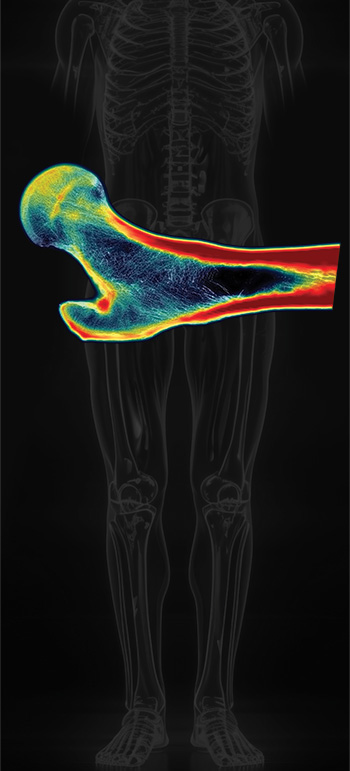
SwRI’s super-resolution technology uses artificial intelligence to create higher-resolution images from CT scans, clearly showing the microstructure of this femur.
SwRI Tool Predicts Fracture Risk
SwRI has developed new technology to enhance clinical bone imaging and decrease osteoporotic fractures in the elderly. Described in a new SwRI-led study, the tool uses artificial intelligence (AI) to create super-resolution (SR) images showing the inner structures of bones in exquisite detail to better determine risk for fracture.
SwRI found that in almost all cases, the SR-enhanced images were more accurate than X-rays or CT scans in quantifying bone characteristics indicative of strength and fracture risk.
Osteoporotic fracture in the elderly is a widespread problem. Half of all women over 55 suffer some sort of fracture at some point. Of the millions of people who break a hip each year, 50% never walk again on their own, and 20% die within a year.
“Engineers and orthopedic clinicians are trying to identify people at risk because interventions can make bones stronger. It’s all about identifying who is at risk,” said SwRI’s Dr. Lance Frazer, the study’s lead author. “Currently, an X-ray or CT scan is the most common method to diagnose fracture risk, but the resolution of both imaging techniques is too low to really determine the structural strength of the bone.”
For this study, SwRI used SR technology, a set of AI techniques that make low-quality images sharper and more detailed.
“Once we have that high-resolution image data, we can better predict just how strong the bone actually is,” Frazer said. “Once we identify bones susceptible to fracture, a doctor can recommend medication or exercises to strengthen vulnerable bones and prevent injury.”
EV Fire Mitigation Technique
SwRI successfully customized and conducted a full-scale evaluation of a novel fire mitigation method designed to safely store damaged electric vehicles (EVs) and batteries. SwRI supports government and industry clients with novel projects to overcome challenges associated with emerging technologies where no standardized testing exists.
“SwRI established the nation’s first fire-focused research program 75 years ago, so our extensive capabilities allow us to develop novel tests to evaluate emerging technologies. For this project, we created a customized test because no standardized test exists yet for EV containment enclosures,” said Senior Research Engineer Kyle Fernandez, who led the experiment.
As the popularity of electric vehicles rises, the likelihood of accidents involving EVs increases. The various makes and models of lithium-ion batteries that power electric and hybrid vehicles can be hazardous when compromised.
“With a lot of emerging industries, the test standards haven’t caught up with the new technologies,” said Karen Carpenter, director of SwRI’s Fire Technology Department.
Transporting or storing damaged EVs for repairs comes with inherent fire risks due to a phenomenon called thermal runaway, which can cause an electric battery to heat up so quickly it sparks a chain reaction that can lead to an out-of-control fire.
“Once an EV gets into an accident, the vehicle is potentially compromised and can catch fire at any point,” said Fernandez.
Using cameras, engineers monitored the fire from a safe location while collecting corresponding temperature and air quality data. While the interior wall reached nearly 2,000 degrees Fahrenheit at the height of the flames, the exterior wall remained cooler at just over 350° F at the peak when the team flooded the container with an extinguishing agent to test its watertight seal. The customized experiment provided valuable data about the enclosure’s effectiveness.

JUICE Instrument Nails Flight Test
As European Space Agency (ESA)’s Jupiter Icy Moons Explorer (Juice) spacecraft hurtled past the Moon and Earth in mid-August to provide its first gravity assist maneuver, the SwRI-led Ultraviolet Spectrograph (UVS) instrument imaged the UV emissions radiating from the Earth and Moon.

The team analyzed the UVS data collected and confirmed that the instrument is working under conditions that couldn’t be replicated in a laboratory setting.
“This high-fidelity test confirmed what the instrument is supposed to do. We can now be confident that the data we will get from Jupiter’s moons will be just as accurate,” said SwRI’s Steven Persyn, Juice-UVS project manager.
Weighing just over 40 pounds and drawing only 7.5 watts of power, UVS is smaller than a microwave oven, yet this powerful instrument will determine the relative concentrations of various elements and molecules in the atmospheres of Jupiter’s moons once in the Jovian system.
Aboard Juice, UVS will get close-up views of the Galilean moons Europa, Ganymede and Callisto, all thought to host liquid water beneath their icy surfaces. UVS will record ultraviolet light emitted, transmitted and reflected by these bodies, revealing the composition of their surfaces and tenuous atmospheres and how they interact with Jupiter and its giant magnetosphere. Additional scientific goals include observations of Jupiter itself as well as the gases from its volcanic moon Io that spread throughout the Jovian magnetosphere.
The Juice spacecraft is now on its way to Venus, where it will complete another gravity assist maneuver before heading back to Earth for another boost to attain the momentum needed for its eight-year, 4-billion-mile journey to the Jovian system.

